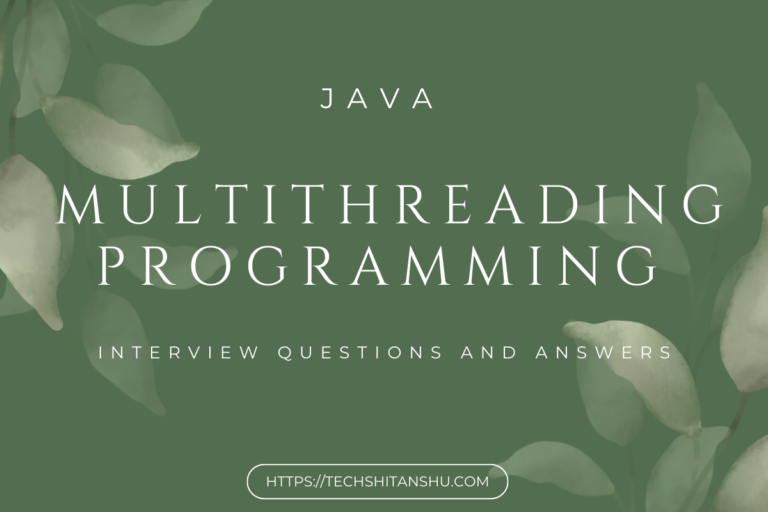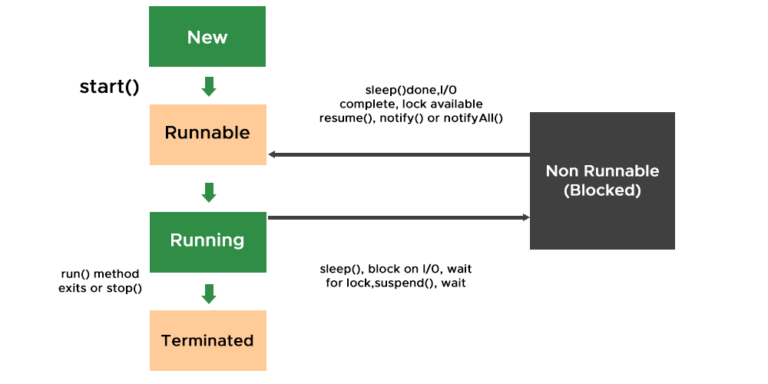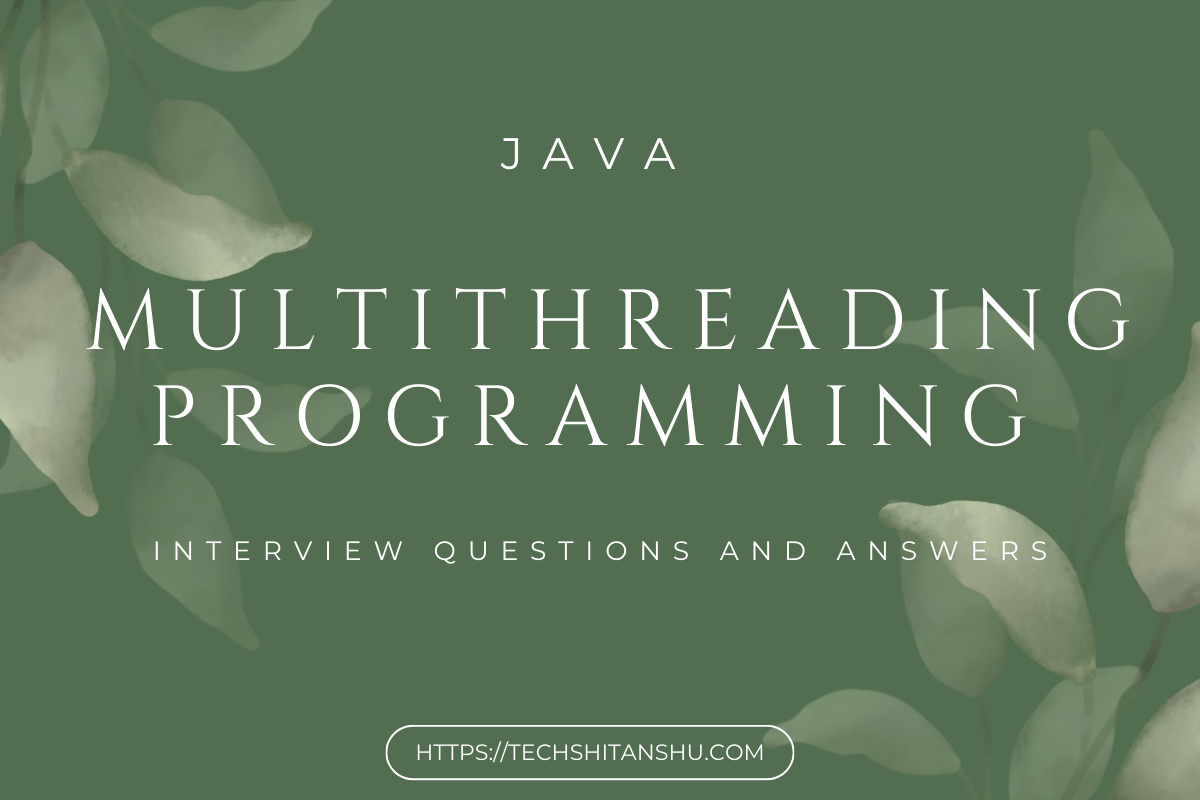Java Multithreading Programming Interview Questions and Answers
Java provides built-in support for multithreaded programming. A multithreaded program contains two or more parts that can run concurrently. Each part of such a program is called a thread, and each thread defines a separate path of execution. Thus, multithreading is a specialised form of multitasking. You are almost certainly acquainted with multitasking because it is supported by virtually all modern operating systems.
However, there are two distinct types of multitasking: process-based and thread-based. It is important to understand the difference between the two. For many readers, process-based multitasking is the more familiar form. A process is, in essence, a program that is executing. Thus, process-based multitasking is the feature that allows your computer to run two or more programs concurrently. For example, process based multitasking enables you to run the Java compiler at the same time that you are using a text editor or visiting a web site. In process-based multitasking, a program is the smallest unit of code that can be dispatched by the scheduler.
In a thread-based multitasking environment, the thread is the smallest unit of dispatchable code. This means that a single program can perform two or more tasks simultaneously. For instance, a text editor can format text at the same time that it is printing, as long as these two actions are being performed by two separate threads. Thus, process-based multitasking deals with the “big picture,” and thread-based multitasking handles the details.
TechShitanshu has prepared a list of the top java multithreaded programming interview questions and answers that are frequently asked in the interview. It is going to help you to crack the java interview questions to get your dream job. Multithreading in Core Java(J2SE) is a very important topic from an interview point of view.

Table of Contents
1. What are processes in java?
Processes are heavyweight tasks that require their own separate address spaces. Multitasking threads require less overhead than multitasking processes. Interprocess communication is expensive and limited. Context switching from one process to another is also costly. Threads, on the other hand, are lighter weight. They share the same address space and cooperatively share the same heavyweight process. Interthread communication is inexpensive, and context switching from one thread to the next is lower in cost. While Java programs make use of process-based multitasking environments, process-based multitasking is not under Java’s control. However, multithreaded multitasking is.
2. What is Thread in Java?
Threads are the lightweight and smallest unit of processing that can be managed independently by a scheduler. Threads are referred to as parts of a process that simply let a program execute efficiently with other parts or threads of the process at the same time. Using threads, one can perform complicated tasks in the easiest way. It is considered the simplest way to take advantage of multiple CPUs available in a machine. They share the common address space and are independent of each other.
3. What is the difference between Process and Thread?
A process is a self contained execution environment and it can be seen as a program or application whereas Thread is a single task of execution within the process. Java runtime environment runs as a single process which contains different classes and programs as processes. Thread can be called lightweight process. Thread requires less resources to create and exists in the process, thread shares the process resources.
4. Explain The Java Thread Model.
The Java run-time system depends on threads for many things, and all the class libraries are designed with multithreading in mind. In fact, Java uses threads to enable the entire environment to be asynchronous. This helps reduce inefficiency by preventing the waste of CPU cycles. The value of a multithreaded environment is best understood in contrast to its counterpart. Single-threaded systems use an approach called an event loop with polling. In this model, a single thread of control runs in an infinite loop, polling a single event queue to decide what to do next.
Once this polling mechanism returns with, say, a signal that a network file is ready to be read, then the event loop dispatches control to the appropriate
event handler. Until this event handler returns, nothing else can happen in the program. This wastes CPU time. It can also result in one part of a program dominating the system and preventing any other events from being processed. In general, in a single-threaded environment, when a thread blocks (that is, suspends execution) because it is waiting for some resource, the entire program stops running.
The benefit of Java’s multithreading is that the main loop/polling mechanism is eliminated. One thread can pause without stopping other parts of your program. For example, the idle time created when a thread reads data from a network or waits for user input can be utilized elsewhere. Multithreading allows animation loops to sleep for a second between each frame without causing the whole system to pause. When a thread blocks in a Java program, only the single thread that is blocked pauses. All other threads continue to run. As most readers know, over the past few years, multi-core systems have become commonplace.
Of course, single-core systems are still in widespread use. It is important to understand that Java’s multithreading features work in both types of systems. In a singlecore system, concurrently executing threads share the CPU, with each thread receiving a slice of CPU time. Therefore, in a single-core system, two or more threads do not actually run at the same time, but idle CPU time is utilized. However, in multi-core systems, it is possible for two or more threads to actually execute simultaneously. In many cases, this can further improve program efficiency and increase the speed of certain operations.
5. What are the benefits of using Multithreading?
Below are various benefits of multithreading:
- Allow the program to run continuously even if a part of it is blocked.
- Improve performance as compared to traditional parallel programs that use multiple processes.
- Allows to write effective programs that utilize maximum CPU time
- Improves the responsiveness of complex applications or programs.
- Increase use of CPU resources and reduce costs of maintenance.
- Saves time and parallelism tasks.
- If an exception occurs in a single thread, it will not affect other threads as threads are independent.
- Less resource-intensive than executing multiple processes at the same time.
6. What are the two ways of implementing thread in Java?
Two ways of implementing thread in java as given below:
- Extending the Thread class
- Implementing Runnable interface in Java
class MultithreadingDemo extends Thread
{
public void run()
{
System.out.println("My thread is in running state.");
}
public static void main(String args[])
{
MultithreadingDemo obj=new MultithreadingDemo();
obj.start();
}
}
class MultithreadingDemo implements Runnable
{
public void run()
{
System.out.println("My thread is in running state.");
}
public static void main(String args[])
{
MultithreadingDemo obj=new MultithreadingDemo();
Threadtobj =new Thread(obj); tobj.start();
}
}
7. What are the different states of a thread, or what is thread lifecycle?
A thread in Java at any point of time exists in any one of the following states. A thread lies only in one of the shown states at any instant:
- New
- Runnable
- Blocked
- Waiting
- Timed Waiting
- Terminated

8. What is difference between user Thread and daemon Thread?
When we create a Thread in java program, it’s known as user thread. A daemon thread runs in background and doesn’t prevent JVM from terminating. When there are no user threads running, JVM shutdown the program and quits. A child thread created from daemon thread is also a daemon thread.
9. Can we call run() method of a Thread class?
Yes, we can call run() method of a Thread class but then it will behave like a normal method. To actually execute it in a Thread, we need to start it using **Thread.start()** method.
10. What do you understand about Thread Priority?
Every thread has a priority, usually higher priority thread gets precedence in execution but it depends on Thread Scheduler implementation that is OS dependent. We can specify the priority of thread but it doesn’t guarantee that higher priority thread will get executed before lower priority thread. Thread priority is an _int_ whose value varies from 1 to 10 where 1 is the lowest priority thread and 10 is the highest priority thread.
11. How can we pause the execution of a Thread for specific time?
We can use Thread class sleep() method to pause the execution of Thread for certain time. Note that this will not stop the processing of thread for specific time, once the thread awake from sleep, it’s state gets changed to runnable and based on thread scheduling, it gets executed.
12. What is Thread Scheduler and Time Slicing?
thread scheduler to decide when each thread should be allowed to run. In theory, over a given period of time, higher-priority threads get more CPU time than lower-priority threads. In practice, the amount of CPU time that a thread gets often depends on several factors besides its priority. (For example, how an operating system implements multitasking can affect the relative availability of CPU time.) A higher-priority thread can also preempt a lower-priority one. For instance, when a lower-priority thread is running and a higher-priority thread resumes (from sleeping or waiting on I/O, for example), it will preempt the lower-priority thread.
Time Slicing is the process to divide the available CPU time to the available runnable threads. Allocation of CPU time to threads can be based on thread priority or the thread waiting for longer time will get more priority in getting CPU time. Thread scheduling can’t be controlled by java, so it’s always better to control it from application itself.
13. How can we make sure main() is the last thread to finish in Java Program?
Just use Thread join() method to make sure all the threads created by the program is dead before finishing the main function.
14. What is context-switching in multi-threading?
Context Switching is the process of storing and restoring of CPU state so that Thread execution can be resumed from the same point at a later point of time. Context Switching is the essential feature for multitasking operating system and support for multi-threaded environment.
15. How does thread communicate with each other?
When threads share resources, communication between Threads is important to coordinate their efforts. Object class wait(), notify() and notifyAll() methods allows threads to communicate about the lock status of a resource.
16. Why thread communication methods wait(), notify() and notifyAll() are in Object class?
In Java every Object has a monitor and wait, notify methods are used to wait for the Object monitor or to notify other threads that Object monitor is free now. There is no monitor on threads in java and synchronization can be used with any Object, that’s why it’s part of Object class so that every class in java has these essential methods for inter thread communication.
17. Why Thread sleep() and yield() methods are static?
Thread sleep() and yield() methods work on the currently executing thread. So there is no point in invoking these methods on some other threads that are in wait state. That’s why these methods are made static so that when this method is called statically, it works on the current executing thread and avoid confusion to the programmers who might think that they can invoke these methods on some non-running threads.
18. How can we achieve thread safety in Java?
There are several ways to achieve thread safety in java – synchronization, atomic concurrent classes, implementing concurrent Lock interface, using volatile keyword, using immutable classes and Thread safe classes.
19. Which is more preferred – Synchronized method or Synchronized block?
Synchronized block is more preferred way because it doesn’t lock the Object, synchronized methods lock the Object and if there are multiple synchronization blocks in the class, even though they are not related, it will stop them from execution and put them in wait state to get the lock on Object.
20. How to create daemon thread in Java?
Thread class setDaemon(true) can be used to create daemon thread in java. We need to call this method before calling start() method else it will throw IllegalThreadStateException.


Leave a Reply